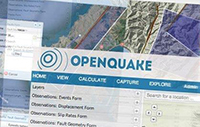Earthquake modelling to create safer communities in southeast Asia
23 September 2014

Screen capture from the OpenQuake platform
Image copyright GEM
Participants from around southeast Asia are meeting in Canberra to be trained in state of the art earthquake modelling techniques to better understand the potential impacts on their communities.
Representatives from Indonesia, Papua New Guinea, the Philippines and Singapore will spend two weeks in a capacity building exercise at Geoscience Australia working with software - called OpenQuake - designed to create earthquake models and scenarios of real events.
"These scenarios will show us what the ground shaking might look like, how it affects the environment, and what areas of population will be impacted" said Dr David Robinson, Program Manager with Geoscience Australia and the Australia-Indonesia Facility for Disaster Reduction.
This knowledge will contribute to each nation's emergency management and mitigation strategies that will then be applied to the cache of information used by disaster managers to help plan for large scale disasters. This training will help with evacuation planning and funding allocation, to practical planning measures such as how many bags of rice or temporary shelters may be required in the immediate aftermath.
"This work informs decisions about how mitigation techniques are most effectively employed. At the end of the day, the work strengthens community resilience to natural hazards, and minimises the risk to life and property."
"Capacity building exercises like this fill a critical information gap in mitigation techniques (such as what to do when large earthquakes occur) because these large events occur infrequently," Dr Robinson said.
The OpenQuake software is a web-based version of the Global Earthquake Model providing an internationally consistent approach to understanding earthquake hazard and risk.
Organisations such as the Association of Southeast Asian Nations (ASEAN) will be able to compare potential impacts of earthquakes across southeast Asian countries and feed that information directly into efforts that support disaster management programs designed to save lives.
This two week program is part of the Australian Government's International Development Program, and is funded through the Australian Department of Foreign Affairs and Trade, and ASEAN, continuing a 40 year old partnership between the two groups.




